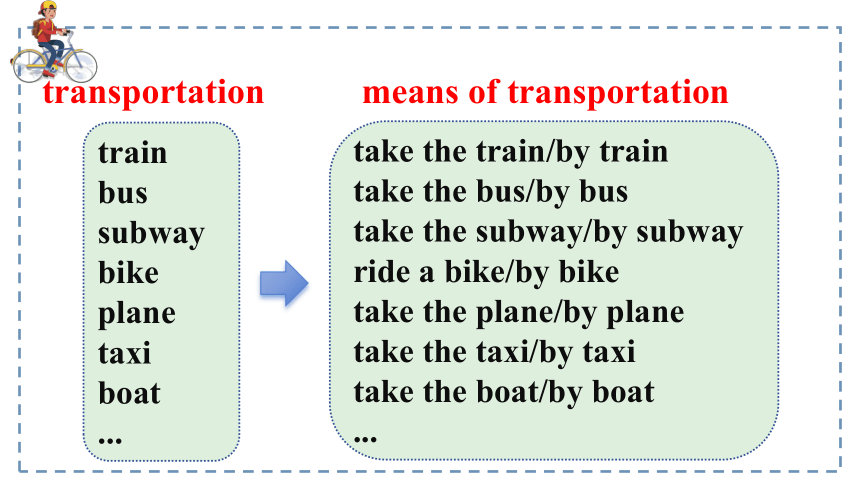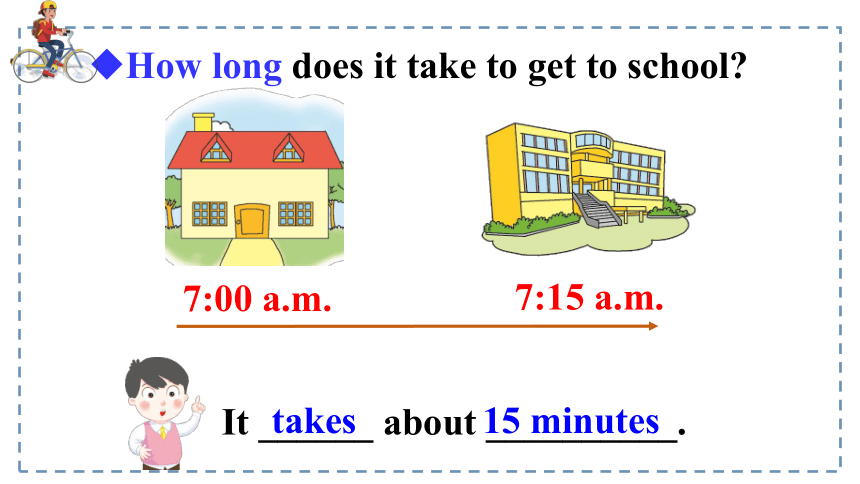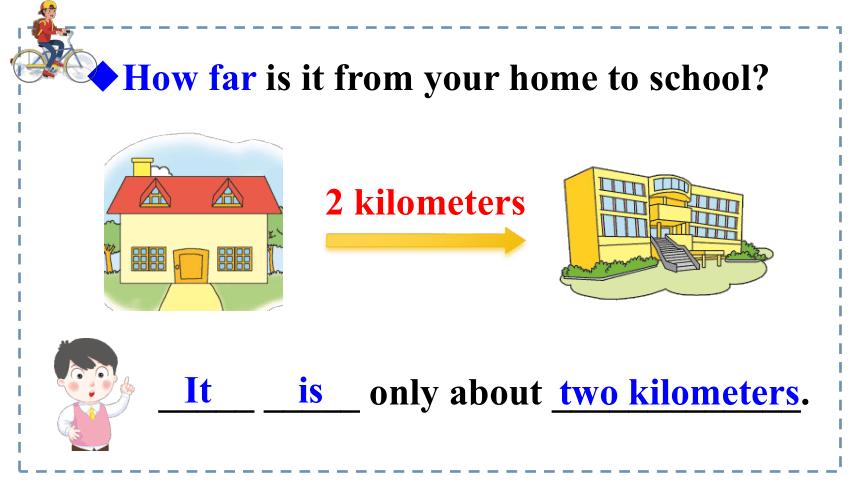人教新目标(Go for it)版七年级下册 Unit 3 How do you get to school? 单元复习课件(共29张PPT)
文档属性
| 名称 | 人教新目标(Go for it)版七年级下册 Unit 3 How do you get to school? 单元复习课件(共29张PPT) |

|
|
| 格式 | pptx | ||
| 文件大小 | 1.1MB | ||
| 资源类型 | 教案 | ||
| 版本资源 | 人教新目标(Go for it)版 | ||
| 科目 | 英语 | ||
| 更新时间 | 2024-03-24 18:48:51 | ||
图片预览









文档简介
(共29张PPT)
Unit 3
How do you get to school
单元复习
单元话题
本单元主题属于“人与社会”范畴,涉及“交通法规、安全意识”。核心语项目是 ask and answer the questions about different means of transportation。要话题是 How do you get to school 围绕交通方式而展开,主要运用“How/How long/How far”询问“去某地的交通方式、时间、距离”。围绕“如何到达学校”这一话题安排了三个任务:一是列举所学的交通工具,从中挑选出各自喜欢的交通方式,并说明原因.巩固并学习一些交通方式的名词:二是让学生互相询问所喜爱的出行方式并根据情况作出描述,学会用 howlong/howfai进行提问与回答了解It takes sb.some time to do sth.句型 三是运用目标语言进行简单的书面描述,进一步复习、巩固所学的语言目标 How do you get toschool How long does he get to school How long does it take 要求学生掌握好助动词 do 在不同人称,特别是第三人称单数后的变化。
take the train/by train
take the bus/by bus
take the subway/by subway
ride a bike/by bike
take the plane/by plane
take the taxi/by taxi
take the boat/by boat
...
train
bus
subway
bike
plane
taxi
boat
...
transportation
means of transportation
take the subway
take the bus
take the car
-How do you get to school every day
-I ________ to school.
ride the bike
7:00 a.m.
7:15 a.m.
How long does it take to get to school
It ______ about __________.
takes
15 minutes
2 kilometers
_____ _____ only about _____________.
How far is it from your home to school
It is
two kilometers
n. 火车
n. 公共汽车
n. 地铁
v. 骑 n. 旅程
n. 自行车
num. 六十
num. 七十
num. 八十
num. 九十
num. 一百
n. 分钟
adv. & adj. 远;远的
train
bus
subway
ride
bike
sixty
seventy
eighty
ninety
hundred
minute
far
n. 千米;公里
adj. 新的;刚出现的
adj. 每一;每个
prep.(表示方式)乘(交通工具)
v. 开车
n. 小汽车;轿车v. 居住;生活
n. 车站;停止
v. 横过;越过
n. 河;江
adj. & pron. 许多
n. 村庄;村镇
kilometer
new
every
by
drive
car
live
stop
cross
river
many
village
words review
根据首字母提示填空。
1. You can go to the bus s ____________to wait for the bus.
2. Henry is 24, so he doesn’t want to l________with his parents.
3. Alice always l_________ home at 7:00 in the morning.
4. You can see many b________ on this river, and some of them are very big.
5. He r_______ his bike to school every morning.
top/station
ive
eaves
oats
ides
Exercises
get to
take the bus/
train/ subway
ride a bike
every day
how far
how long
1. 到达
2. 乘公共汽车/
火车/地铁
3. 骑自行车
4. 每天
5. 多远
6. 多长时间
have a good day
walk to school
bus stop
7. 度过愉快的一天
8. 步行上学
9. 公交车站点
10. 公共汽车/火车
/地铁站
11. 认为;想起
bus/ train/ subway station
think of
cross the river
between … and …
go on a ropeway
an/ one 11-year-old boy
come true
12. 过河
13. 在……和……之间
14. 乘索道
15. 一个11岁的男孩
16. 实现;成为现实
Phrase review
根据句意用方框中所给短语的适当形式填空。
every day,by bike,come true,between...and...;think of,take the subway
1. What do you _________________ this sports show
2. She often comes to my home _________ six _________ seven o’clock in the evening.
3. Can his dream to be a doctor __________________
4. Sometimes Gina gets to school __________________.
5.They need cars to go shopping or go to work __________________.
think of
between and
come true
by bike
every day
Exercises
1.---玛丽怎样去学校?---她乘地铁(去学校)。
---______ does Mary _______ _____ _________ ---She _______ ______ ________.
2.我每天骑自行车去学校。
I ______ it to school _______ _____.
3.从你家到学校有多远?
_______ _____ _____ _____ from your home to school
How
get to school
takes the subway
ride
every day
How far is it
4.---你到学校要花费多长时间?
---骑自行车大约十五分钟。它是很好的锻炼(方式)。
---_______ _____ does it _____ you to _______ _____ school
---About 15 minutes _______ _____.It's good exercise.
5.嗯,祝你上学愉快。Well,_______ ______ ______ _____ at school.
How long
take
get to
by bike
have a good day
sentences review
6.玛丽想知道他认为这段旅程怎么样。
Mary wants to know _______ _____ ______ _____ the trip.
7.对许多学生来说,到学校是容易的。
For many students,____ ___ _______ ___ get to school.
8.(河上)没有桥梁,而且对于船只来说河水流动得太快了。
_______ _____ no bridge and the river _______ _____ _______ for boats.
What he thinks of
it is easy to
There is
runs too quickly
9.他们的梦想是有一座桥。
_____ ___ _______ _______ to have a bridge.
10.十一岁的男孩亮亮每天过河去上学。
One _____________ boy,Liangliang,_______ the river every school day.
11.他们的梦想能够实现吗?_______ their dream _______ _____
12.乘公共汽车到那里要花费大约40分钟。
It _______ about 40 minutes ______ _______ there by bus.
It is their dream
11-year-old
crosses
Can
come true
takes
to get
sentences review
how, how long与how far引导的特殊疑问句
how是疑问副词,意为“怎样;如何”,常用来引导特殊疑问句。本单元主要用来询问交通方式,其答语通常有以下几种:
how引导的特殊疑问句
Grammar review
1. How do/does + 某人 + ___________
某人怎么去某地?
how是疑问副词, 本句中用来提问__________ 等。
出行方式
get to 某地
2. 回答方式有两种:
A: 某人 + take/ride(s) + _________________ + to 某地.
B: 某人 + get(s) to 某地 + ____________.
限定词+ 交通工具
by 交通工具
3. It takes sb. some time to do sth.
意为:___________________________
某事花费某人……时间。
Grammar review
4. 如果对时间段提问的话,就用
_________ + does it take (sb.) to do sth. 句型。
How long
5. 对两地间的距离提问下列句型:
_______ + is it _____ A ___ B?
How far
from to
Grammar review
拓展
how引导特殊疑问句的其他常见用法如下:
询问天气
询问程度、看法
询问方式、
手段、方法
询问健康
状况
你认为北京怎么样?
How do you like Beijing
今天的天气怎么样?
How is the weather today
我怎样才能帮到你?
How can l help you
你的爸爸身体怎么样?
How is your father
How...
Grammar review
1. — ______ is it from Haikou to Sanya
—It’s about three hours’ drive.
A. How soon B. How long C. How far
2. —Excuse me, ______ is this T-shirt
—It’s 88 yuan.
A. how much B. how many
C. how long D. how old
单项选择
Exercises
3. — ______ does it take you to get to school by bike
—About fifteen minutes.
A. How soon B. How often
C. How long D. How far
4. — ______ students are there in your class
—Fifty.
A. How many B. How much
C. How long D. How far
Exercises
A: __________________________
B: I usually ride my bike.
A: ________is it from your home to school
B: About 10 kilometers.
A: _________does it take
B: It _______me around 35 minutes.
补全对话。
How do you get to school
How far
How long
takes
Exercises
How do you get to school?你怎样去上学?
how是疑问副词,意为“如何;怎样;以何种方式;用什么手段”。本句中how引导的特殊疑问句,用来询问交通方式。其回答方式有两种:
①主语+take(s)/ride(s)+限定词+表示交通工具的名词+to+地点.
②主语+go(es)/get(s) to+地点+by+交通工具类的单数名词或on/in+限定词+表示交通工具的名词.
language points
The bus ride takes about 20 minutes.乘公共汽车要花20分钟。
take的意思是“花费(时间)”,通常用某件事情作其主语,常用句式为:
It takes (sb.) some time to do sth.表示“做某事花费(某人)多长时间”。其中it为形式主语,真正的主语为后面的动词不定式。
【易混辨析】take,spend,cost与pay
language points
take 其后可跟双宾语,常用It takes sb.+时间+to do sth.
做某事花了某人多少时间。
spend 其主语必须是人,常用sb.spend(s) time/money on sth.
某人在……上花费时间/金钱。
sb. spend(s) time/money (in) doing sth.
某人花费时间/金钱做某事。
cost 其主语是物,常用sth.cost(s) (sb.) +金钱,某物花了(某人)多少钱。
pay pay (sb.) money for sth.付钱(给某人)买……;pay for sth.付……的钱;pay for sb.替某人付钱。
language points
For many students,it is easy to get to school.对于许多学生来说,到达学校是容易的。
“It is+形容词+不定式”是固定句式,意思是“做某事怎么样”;这是一个动词不定式作主语的句型,但不放在句首,用it作形式主语。不定式前可加for sb.,意为“就……而言;对于……”。
【拓展延伸】it引导的该句型有两种,完整形式如下:
language points
①It is+adj.+for sb.to do sth.对某人来说做某事……(此时形容词修饰to do sth.),该句型中的形容词是描述某事物对某人来说有何影响,形容词多用important,necessary(必需的),impossible(不可能的)等。
②It is+adj.+of sb.to do sth.某人做某事……(此时形容词修饰sb.),该句型中的形容词是描述人的性格、品质等,如clever,good,kind,nice,wrong等。
language points
单项选择。
--____ does it take to school --10 minutes.
A. How often B. How long
C. How many D. How much
2. -- ____ is it from Xiangfan to Wuhan
-- About 300 kilometers.
A. How far B. How old C. How many D. Where
3. He has a quick breakfast, and then leaves
___ school ___ sixty thirty.
A. for; for B. from; for C. for; at D. for; in
Exercises
4. Some students go to school by boat, but
___ go by bus.
A. other B. some other
C. other’s D. others
5. I have a map of the U.S.A here, but it’s
___ English.
A. with B. for C. in D. at
6. ____ do you like the transportation in
your town
A. What B. How C. When D. How’s
Exercises
话题概述
本单元以“交通出行”为话题,要求学生会写介绍交通出行方式的作文。写作时,注意正确使用表达乘坐交通工具、两地距离和花费时间的短语及句型。此外,有时还要对交通方式作简要的评价。
自我介绍
Hello, I’m Tina.
具体介绍家人的职业及出行方式
简单评价
My father is a… He usually drives
his car…
My mother is a… She usually goes
to work by… Sometimes she…
I’m a… I usually ride a bike… It
takes me…
I love going to school by bike because I think it is good for my health.
谋篇布局
Hello. I’m Tina. My father is a musician. He often
drives his car to work. My mother is a Chinese teacher.
She usually goes to work by bus. Sometimes she takes
the subway. I’m a student. I usually ride a bike to school
because the school isn’t far from my home. It takes me
only l0 minutes to get to school. I love going to school
by bike because I think it is good for my health.
范文欣赏
Unit 3
How do you get to school
单元复习
单元话题
本单元主题属于“人与社会”范畴,涉及“交通法规、安全意识”。核心语项目是 ask and answer the questions about different means of transportation。要话题是 How do you get to school 围绕交通方式而展开,主要运用“How/How long/How far”询问“去某地的交通方式、时间、距离”。围绕“如何到达学校”这一话题安排了三个任务:一是列举所学的交通工具,从中挑选出各自喜欢的交通方式,并说明原因.巩固并学习一些交通方式的名词:二是让学生互相询问所喜爱的出行方式并根据情况作出描述,学会用 howlong/howfai进行提问与回答了解It takes sb.some time to do sth.句型 三是运用目标语言进行简单的书面描述,进一步复习、巩固所学的语言目标 How do you get toschool How long does he get to school How long does it take 要求学生掌握好助动词 do 在不同人称,特别是第三人称单数后的变化。
take the train/by train
take the bus/by bus
take the subway/by subway
ride a bike/by bike
take the plane/by plane
take the taxi/by taxi
take the boat/by boat
...
train
bus
subway
bike
plane
taxi
boat
...
transportation
means of transportation
take the subway
take the bus
take the car
-How do you get to school every day
-I ________ to school.
ride the bike
7:00 a.m.
7:15 a.m.
How long does it take to get to school
It ______ about __________.
takes
15 minutes
2 kilometers
_____ _____ only about _____________.
How far is it from your home to school
It is
two kilometers
n. 火车
n. 公共汽车
n. 地铁
v. 骑 n. 旅程
n. 自行车
num. 六十
num. 七十
num. 八十
num. 九十
num. 一百
n. 分钟
adv. & adj. 远;远的
train
bus
subway
ride
bike
sixty
seventy
eighty
ninety
hundred
minute
far
n. 千米;公里
adj. 新的;刚出现的
adj. 每一;每个
prep.(表示方式)乘(交通工具)
v. 开车
n. 小汽车;轿车v. 居住;生活
n. 车站;停止
v. 横过;越过
n. 河;江
adj. & pron. 许多
n. 村庄;村镇
kilometer
new
every
by
drive
car
live
stop
cross
river
many
village
words review
根据首字母提示填空。
1. You can go to the bus s ____________to wait for the bus.
2. Henry is 24, so he doesn’t want to l________with his parents.
3. Alice always l_________ home at 7:00 in the morning.
4. You can see many b________ on this river, and some of them are very big.
5. He r_______ his bike to school every morning.
top/station
ive
eaves
oats
ides
Exercises
get to
take the bus/
train/ subway
ride a bike
every day
how far
how long
1. 到达
2. 乘公共汽车/
火车/地铁
3. 骑自行车
4. 每天
5. 多远
6. 多长时间
have a good day
walk to school
bus stop
7. 度过愉快的一天
8. 步行上学
9. 公交车站点
10. 公共汽车/火车
/地铁站
11. 认为;想起
bus/ train/ subway station
think of
cross the river
between … and …
go on a ropeway
an/ one 11-year-old boy
come true
12. 过河
13. 在……和……之间
14. 乘索道
15. 一个11岁的男孩
16. 实现;成为现实
Phrase review
根据句意用方框中所给短语的适当形式填空。
every day,by bike,come true,between...and...;think of,take the subway
1. What do you _________________ this sports show
2. She often comes to my home _________ six _________ seven o’clock in the evening.
3. Can his dream to be a doctor __________________
4. Sometimes Gina gets to school __________________.
5.They need cars to go shopping or go to work __________________.
think of
between and
come true
by bike
every day
Exercises
1.---玛丽怎样去学校?---她乘地铁(去学校)。
---______ does Mary _______ _____ _________ ---She _______ ______ ________.
2.我每天骑自行车去学校。
I ______ it to school _______ _____.
3.从你家到学校有多远?
_______ _____ _____ _____ from your home to school
How
get to school
takes the subway
ride
every day
How far is it
4.---你到学校要花费多长时间?
---骑自行车大约十五分钟。它是很好的锻炼(方式)。
---_______ _____ does it _____ you to _______ _____ school
---About 15 minutes _______ _____.It's good exercise.
5.嗯,祝你上学愉快。Well,_______ ______ ______ _____ at school.
How long
take
get to
by bike
have a good day
sentences review
6.玛丽想知道他认为这段旅程怎么样。
Mary wants to know _______ _____ ______ _____ the trip.
7.对许多学生来说,到学校是容易的。
For many students,____ ___ _______ ___ get to school.
8.(河上)没有桥梁,而且对于船只来说河水流动得太快了。
_______ _____ no bridge and the river _______ _____ _______ for boats.
What he thinks of
it is easy to
There is
runs too quickly
9.他们的梦想是有一座桥。
_____ ___ _______ _______ to have a bridge.
10.十一岁的男孩亮亮每天过河去上学。
One _____________ boy,Liangliang,_______ the river every school day.
11.他们的梦想能够实现吗?_______ their dream _______ _____
12.乘公共汽车到那里要花费大约40分钟。
It _______ about 40 minutes ______ _______ there by bus.
It is their dream
11-year-old
crosses
Can
come true
takes
to get
sentences review
how, how long与how far引导的特殊疑问句
how是疑问副词,意为“怎样;如何”,常用来引导特殊疑问句。本单元主要用来询问交通方式,其答语通常有以下几种:
how引导的特殊疑问句
Grammar review
1. How do/does + 某人 + ___________
某人怎么去某地?
how是疑问副词, 本句中用来提问__________ 等。
出行方式
get to 某地
2. 回答方式有两种:
A: 某人 + take/ride(s) + _________________ + to 某地.
B: 某人 + get(s) to 某地 + ____________.
限定词+ 交通工具
by 交通工具
3. It takes sb. some time to do sth.
意为:___________________________
某事花费某人……时间。
Grammar review
4. 如果对时间段提问的话,就用
_________ + does it take (sb.) to do sth. 句型。
How long
5. 对两地间的距离提问下列句型:
_______ + is it _____ A ___ B?
How far
from to
Grammar review
拓展
how引导特殊疑问句的其他常见用法如下:
询问天气
询问程度、看法
询问方式、
手段、方法
询问健康
状况
你认为北京怎么样?
How do you like Beijing
今天的天气怎么样?
How is the weather today
我怎样才能帮到你?
How can l help you
你的爸爸身体怎么样?
How is your father
How...
Grammar review
1. — ______ is it from Haikou to Sanya
—It’s about three hours’ drive.
A. How soon B. How long C. How far
2. —Excuse me, ______ is this T-shirt
—It’s 88 yuan.
A. how much B. how many
C. how long D. how old
单项选择
Exercises
3. — ______ does it take you to get to school by bike
—About fifteen minutes.
A. How soon B. How often
C. How long D. How far
4. — ______ students are there in your class
—Fifty.
A. How many B. How much
C. How long D. How far
Exercises
A: __________________________
B: I usually ride my bike.
A: ________is it from your home to school
B: About 10 kilometers.
A: _________does it take
B: It _______me around 35 minutes.
补全对话。
How do you get to school
How far
How long
takes
Exercises
How do you get to school?你怎样去上学?
how是疑问副词,意为“如何;怎样;以何种方式;用什么手段”。本句中how引导的特殊疑问句,用来询问交通方式。其回答方式有两种:
①主语+take(s)/ride(s)+限定词+表示交通工具的名词+to+地点.
②主语+go(es)/get(s) to+地点+by+交通工具类的单数名词或on/in+限定词+表示交通工具的名词.
language points
The bus ride takes about 20 minutes.乘公共汽车要花20分钟。
take的意思是“花费(时间)”,通常用某件事情作其主语,常用句式为:
It takes (sb.) some time to do sth.表示“做某事花费(某人)多长时间”。其中it为形式主语,真正的主语为后面的动词不定式。
【易混辨析】take,spend,cost与pay
language points
take 其后可跟双宾语,常用It takes sb.+时间+to do sth.
做某事花了某人多少时间。
spend 其主语必须是人,常用sb.spend(s) time/money on sth.
某人在……上花费时间/金钱。
sb. spend(s) time/money (in) doing sth.
某人花费时间/金钱做某事。
cost 其主语是物,常用sth.cost(s) (sb.) +金钱,某物花了(某人)多少钱。
pay pay (sb.) money for sth.付钱(给某人)买……;pay for sth.付……的钱;pay for sb.替某人付钱。
language points
For many students,it is easy to get to school.对于许多学生来说,到达学校是容易的。
“It is+形容词+不定式”是固定句式,意思是“做某事怎么样”;这是一个动词不定式作主语的句型,但不放在句首,用it作形式主语。不定式前可加for sb.,意为“就……而言;对于……”。
【拓展延伸】it引导的该句型有两种,完整形式如下:
language points
①It is+adj.+for sb.to do sth.对某人来说做某事……(此时形容词修饰to do sth.),该句型中的形容词是描述某事物对某人来说有何影响,形容词多用important,necessary(必需的),impossible(不可能的)等。
②It is+adj.+of sb.to do sth.某人做某事……(此时形容词修饰sb.),该句型中的形容词是描述人的性格、品质等,如clever,good,kind,nice,wrong等。
language points
单项选择。
--____ does it take to school --10 minutes.
A. How often B. How long
C. How many D. How much
2. -- ____ is it from Xiangfan to Wuhan
-- About 300 kilometers.
A. How far B. How old C. How many D. Where
3. He has a quick breakfast, and then leaves
___ school ___ sixty thirty.
A. for; for B. from; for C. for; at D. for; in
Exercises
4. Some students go to school by boat, but
___ go by bus.
A. other B. some other
C. other’s D. others
5. I have a map of the U.S.A here, but it’s
___ English.
A. with B. for C. in D. at
6. ____ do you like the transportation in
your town
A. What B. How C. When D. How’s
Exercises
话题概述
本单元以“交通出行”为话题,要求学生会写介绍交通出行方式的作文。写作时,注意正确使用表达乘坐交通工具、两地距离和花费时间的短语及句型。此外,有时还要对交通方式作简要的评价。
自我介绍
Hello, I’m Tina.
具体介绍家人的职业及出行方式
简单评价
My father is a… He usually drives
his car…
My mother is a… She usually goes
to work by… Sometimes she…
I’m a… I usually ride a bike… It
takes me…
I love going to school by bike because I think it is good for my health.
谋篇布局
Hello. I’m Tina. My father is a musician. He often
drives his car to work. My mother is a Chinese teacher.
She usually goes to work by bus. Sometimes she takes
the subway. I’m a student. I usually ride a bike to school
because the school isn’t far from my home. It takes me
only l0 minutes to get to school. I love going to school
by bike because I think it is good for my health.
范文欣赏
同课章节目录
- Unit 1 Can you play the guitar?
- Section A
- Section B
- Unit 2 What time do you go to school?
- Section A
- Section B
- Unit 3 How do you get to school?
- Section A
- Section B
- Unit 4 Don't eat in class.
- Section A
- Section B
- Unit 5 Why do you like pandas?
- Section A
- Section B
- Unit 6 I'm watching TV.
- Section A
- Section B
- Review of Units 1-6
- Unit 7 It's raining!
- Section A
- Section B
- Unit 8 Is there a post office near here?
- Section A
- Section B
- Unit 9 What does he look like?
- Section A
- Section B
- Unit 10 I'd like some noodles.
- Section A
- Section B
- Unit 11 How was your school trip?
- Section A
- Section B
- Unit 12 What did you do last weekend?
- Section A
- Section B
